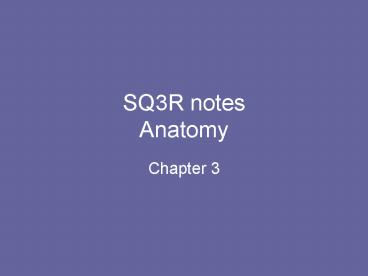SQ3R notes Anatomy - PowerPoint PPT Presentation
1 / 26
Title:
SQ3R notes Anatomy
Description:
... are filter cells in the kidney. See page 63. 11. How does ... Caffeine is a diuretic. 12. What are urinary disorders? Infections. Kidney stones. Kidney disease ... – PowerPoint PPT presentation
Number of Views:46
Avg rating:3.0/5.0
Title: SQ3R notes Anatomy
1
SQ3R notesAnatomy
- Chapter 3
2
1. What is the digestive system?
- Food must be broken down to a form that cells can
use - Digestive tract
- 8 organs joined together end to end
3
2. How is food broken down in the digestive tract?
- 2 types of digestion
- Mechanicalphysically crushing the food into
smaller pieces
4
- Chemical digestion
- Large molecules are broken down into nutrients by
enzymes - Enzymes are chemicals used by the body to break
down food into smaller molecules
5
- There are 3 types of nutrients
- -carbohydrates
- -proteins
- -fats
6
3. What happens in the mouth?
- Chewing is needed to swallow food and to speed up
chemical digestion
7
- Saliva is mixed with the small pieces to start
chemical digestion
8
- Esophagus contracts by peristalsis to swallow
9
4. What happens in the stomach?
- Mechanical digestion squeezing
- Chemical digestion acid and enzymes added to
the food
10
- Chyme the soupy mix of food, acid, and enzymes
11
- Valve at the end of the stomach controls amount
of chyme that is released into the small intestine
12
5. What does the small intestine and pancreas do?
- Very long---6 meters
- Absorbs food particles into the blood by diffusion
13
- Lined with villi (small finger like projections)
14
- Pancreas is located between stomach and small
intestine - Secretes pancreatic juice into small intestine
15
- Pancreatic juice neautralizes the acid in the
chyme and adds more enzymes
16
6. What do the liver and gall bladder do?
- Liver has 4 jobs
- Make bile (digests fat)
- Store nutrients not needed immediately
- Breaks down toxins
- Makes cholesterol (used to make hormones)
17
- Gallbladder
- Stores bile and releases it into the small
intestine
18
7. What happens in the large intestine?
- Hold nondigestible material
- Takes out water from left over material and
returns it to the blood - Waste material turns solid and is excreted out
the body
19
8. What are some digestive problems?
- Heart burn
- Colon cancer
- Gastric ulcer
- Constipation
- Diarrhea
20
9. What does the urinary system do?
- Excretion---removing waste through a membrane
- Skin sweat
- Lungs CO2
- Urinary system waste from blood
21
- Kidney
- Bladder
- vessels
22
10. How do the kidneys work?
- 2000 liters of blood filtered a day
- Blood cycles through 350 times a day
23
- Nephrons are filter cells in the kidney
- See page 63
24
11. How does water affect your body?
- Water balance controlled by hormones
- Water level down less water in saliva dry
mouth
25
- Diuretics cause kidneys to take water from body
and make you more thirsty - Caffeine is a diuretic
26
12. What are urinary disorders?
- Infections
- Kidney stones
- Kidney disease































